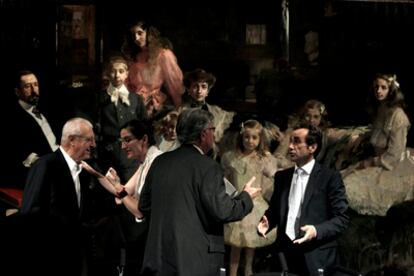Redeeming the Belle Époque
New Barcelona show digs up the roots of the 20th century
In the art world, the 1870s marked the beginning of a period that came to be known by the somewhat derogatory term of the Belle Époque. But art historian Tomás Llorens brings new perspective to this era in Retratos de la Belle Époque (or, Portraits of the Belle Époque), an exhibition that opened Tuesday at CaixaForum Barcelona after premiering in Valencia.
The show, which runs until October 9, brings together 76 works by around 40 artists, on loan from over 30 museums and private collections, making this an ambitious and, in a way, daring proposition.
"We wanted to reconstruct the context and provide a historical review of a period that has been slapped with such a derogatory label that even historians are loathe to use it," explains Llorens. "That is precisely why I deliberately wanted to use it in the title [of the show]. This period not only contains the sources of the 20th century, but it is quite interesting in its own right in terms of art, music and literature... it is Proust's time."
A selection of self-portraits by artists such as Joaquín Sorolla, John Singer Sargent and Asta Norregaard opens a fascinating exhibition that harbors echoes of an unbalanced society speeding headlong toward the assassination of Franz Ferdinand in Sarajevo, which sparked World War I, and marks the chronological end of the show.
Llorens' well-known talent for organizing art shows is evident in this succession of perfectly structured rooms that provide the iconographic and psychological keys to understanding a turning point in stylistic conventions and the relationship between the artist, the public and the market. Following this line of thought, the show ranges from society portraits that reflect the triumphant feeling of the early years, fueled by sustained economic growth, to the anxiety and uncertainty visible on pre-war faces painted by the likes of Anglada Camarasa, Egon Schiele, Oskar Kokoschka and Ernst Ludwig Kirchner.
One of the biggest surprises is the presence of Giovanni Boldini with his spectacular Lady in Rose and portrait of Cléo de Mérode, who was also a model for Toulouse-Lautrec. The latter, in turn, is present at the show with six artworks, despite the extreme difficulty of getting his work loaned out.
There are also particularly interesting artworks by Russian and Scandinavian artists who are not well represented in Spanish collections, apart from the Thyssen Foundation's - which Llorens directed for many years.
One of the stars of the show is the Valencian artist Joaquín Sorolla, who was a master at capturing the society of his time. "Up until World War I, Sorolla was a far more international artist than Picasso," notes Llorens.
Retratos de la Belle Époque . Until October 9 at CaixaForum Barcelona, Av. Francesc Ferrer i Guàrdia 6-8, Barcelona. www.caixaforum.com

Tu suscripción se está usando en otro dispositivo
¿Quieres añadir otro usuario a tu suscripción?
Si continúas leyendo en este dispositivo, no se podrá leer en el otro.
FlechaTu suscripción se está usando en otro dispositivo y solo puedes acceder a EL PAÍS desde un dispositivo a la vez.
Si quieres compartir tu cuenta, cambia tu suscripción a la modalidad Premium, así podrás añadir otro usuario. Cada uno accederá con su propia cuenta de email, lo que os permitirá personalizar vuestra experiencia en EL PAÍS.
¿Tienes una suscripción de empresa? Accede aquí para contratar más cuentas.
En el caso de no saber quién está usando tu cuenta, te recomendamos cambiar tu contraseña aquí.
Si decides continuar compartiendo tu cuenta, este mensaje se mostrará en tu dispositivo y en el de la otra persona que está usando tu cuenta de forma indefinida, afectando a tu experiencia de lectura. Puedes consultar aquí los términos y condiciones de la suscripción digital.
Últimas noticias
The complicated life of Francesca Albanese: A rising figure in Italy but barred from every bank by Trump’s sanctions
How Japan is trying to avert ‘digital defeat’
Half of Scotland is in the hands of 420 property owners
From digital curfews to blocking apps: How technology experts protect their children online
Most viewed
- Why we lost the habit of sleeping in two segments and how that changed our sense of time
- Pablo Escobar’s hippos: A serious environmental problem, 40 years on
- Trump’s obsession with putting his name on everything is unprecedented in the United States
- The Florida Keys tourist paradise is besieged by immigration agents: ‘We’ve never seen anything like this’
- Charles Dubouloz, mountaineering star, retires at 36 with a farewell tour inspired by Walter Bonatti








































